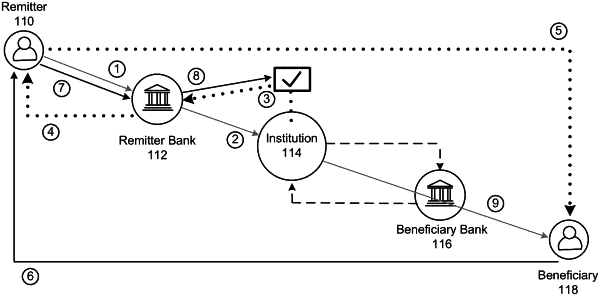| CPC G06Q 20/027 (2013.01) [H04L 41/12 (2013.01); H04L 67/12 (2013.01)] | 16 Claims |

|
1. A system that implements an interbank information network architecture that provides a secure and decentralized network, the system comprising:
an interbank information network utilizing a dedicated private third-party infrastructure hosted by a third party hosting provider at a data center that establishes a direct communication channel between a plurality of nodes, the interbank information network comprising:
an administrator node, managed by one of a third-party and a regulator, configured to maintain a whitelist of nodes that may exchange information as well as controlling permissions including sending decryption keys to authorized nodes;
a first bank node communicatively coupled to a first in-bank system; the first bank node comprises:
a client internal system that communicates with application business logic via an application programming interface (API), the API requiring one or more access keys for access to the interbank information network and the one or more access keys are secured in a key-vault, the client internal system is configured to receive a transaction request; and
a first blockchain node that supports a permissioned shared ledger and a private database that contains transactional, customer and personally identifiable information (PII), the first blockchain node is configured to record and publish to the permissioned shared ledger, inquiry activity based on the transaction request that is encrypted by the interbank information network; and
a second bank node communicatively coupled to a second in-bank system, the second bank node including
a private database that contains transactional, customer and personally identifiable information (PII),
a stager representing an application programming interface and configured to
receive the request from the first bank node, and
represent the request as a smart contract to retrieve information from the private database of the second bank node based on the received request, and
a second blockchain node that supports the permissioned shared ledger, the second bank node configured to:
replicate, via the second blockchain node over direct communication channel, the inquiry activity published by the first blockchain node;
receive, upon a determination by the interbank information network that the second bank node is authorized, a previously generated decryption key for the encrypted inquiry activity based on the transaction request from the administrator node;
determine, via the second in-bank system, an answer to the inquiry activity based on one or more of a fraud check, tracking, and validation processing;
record and publish to the permissioned shared ledger, via the second blockchain node, the answer to the inquiry activity, the interbank information network verifying the answer to the inquiry activity including leveraging a network wide fraudster list, wherein
the first bank node is configured to send a private message directly to the second bank node, the direct private message including a sanction inquiry including a request for beneficiary information to the second bank node,
the stager retrieves the requested information in the sanction inquiry, and
the second bank node is configured to retrieve information answering the sanction inquiry from the private database of the second bank node, and
the second bank node is configured to send a private message directly to the first bank node answering the sanction inquiry and including an account holder's name and address.
|